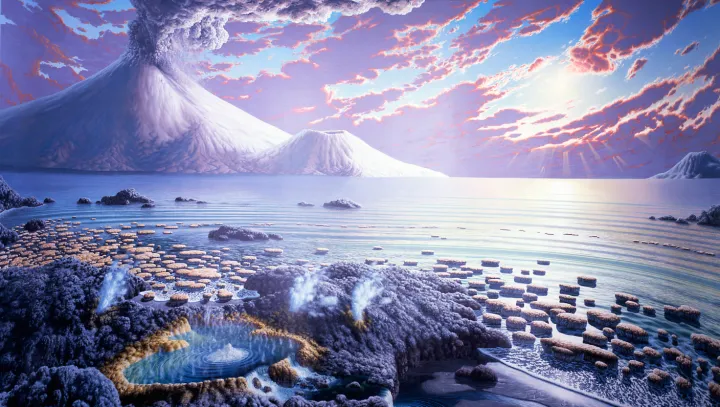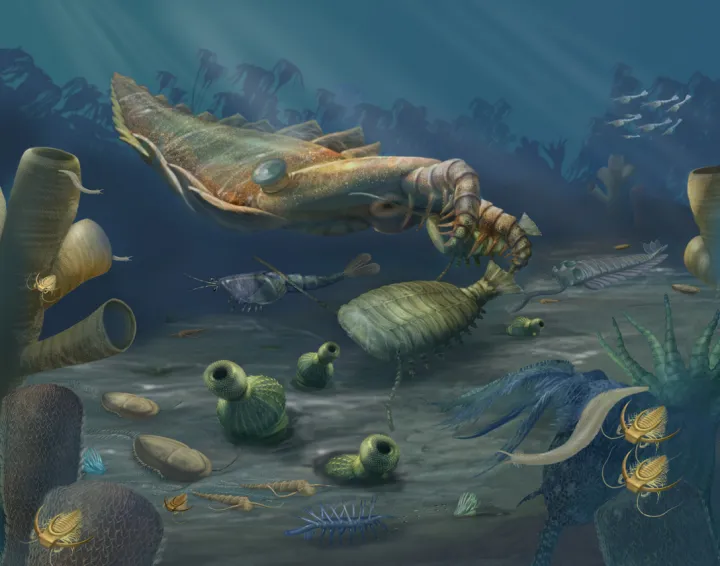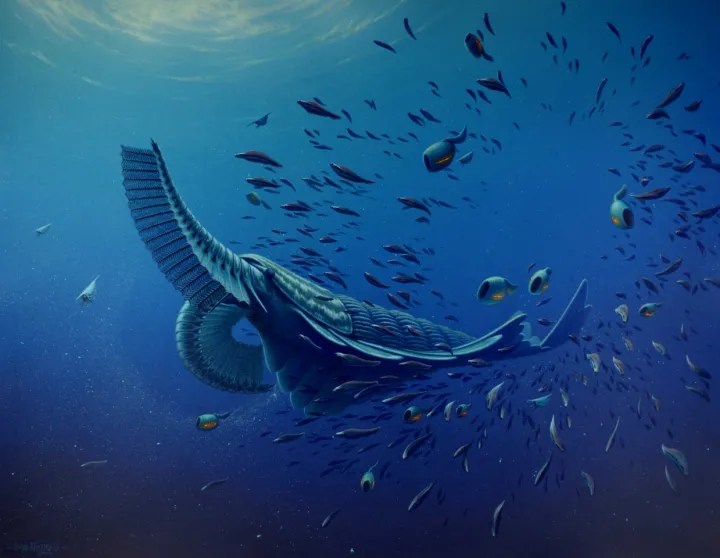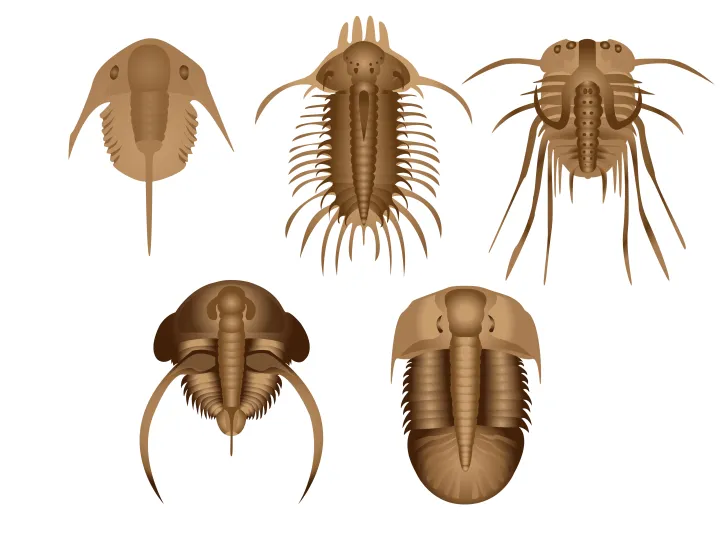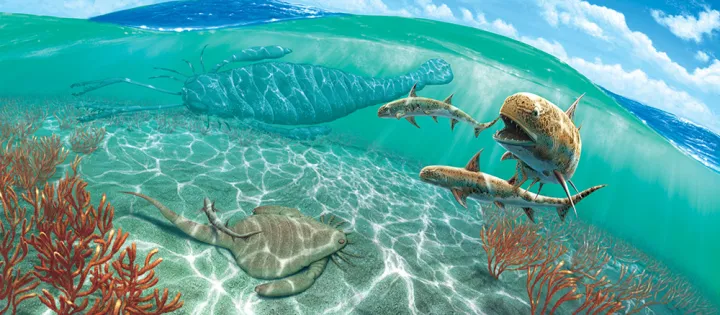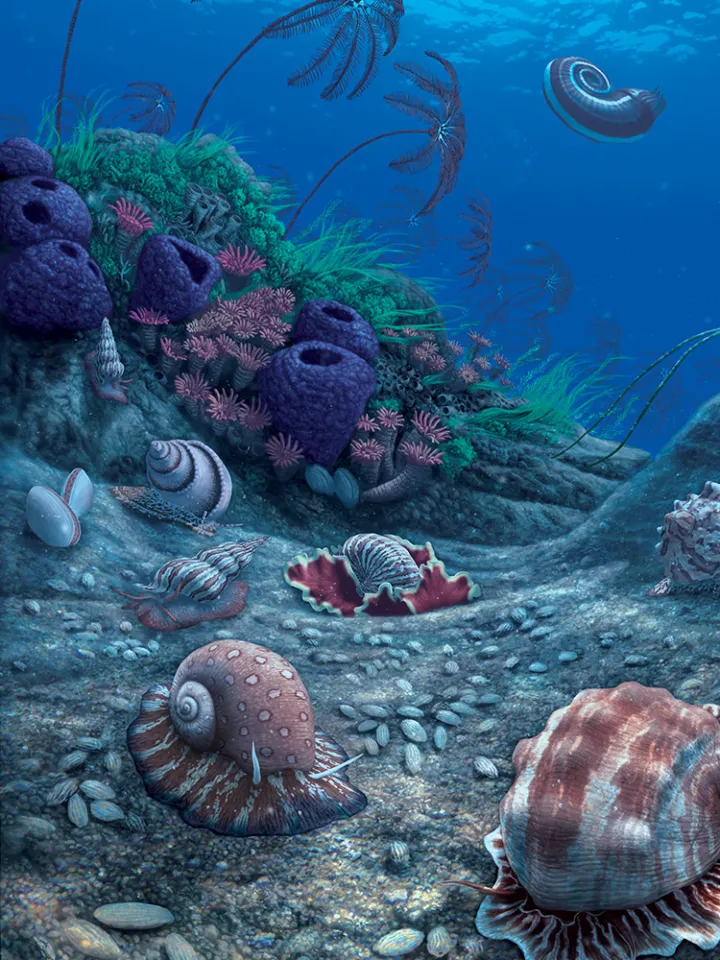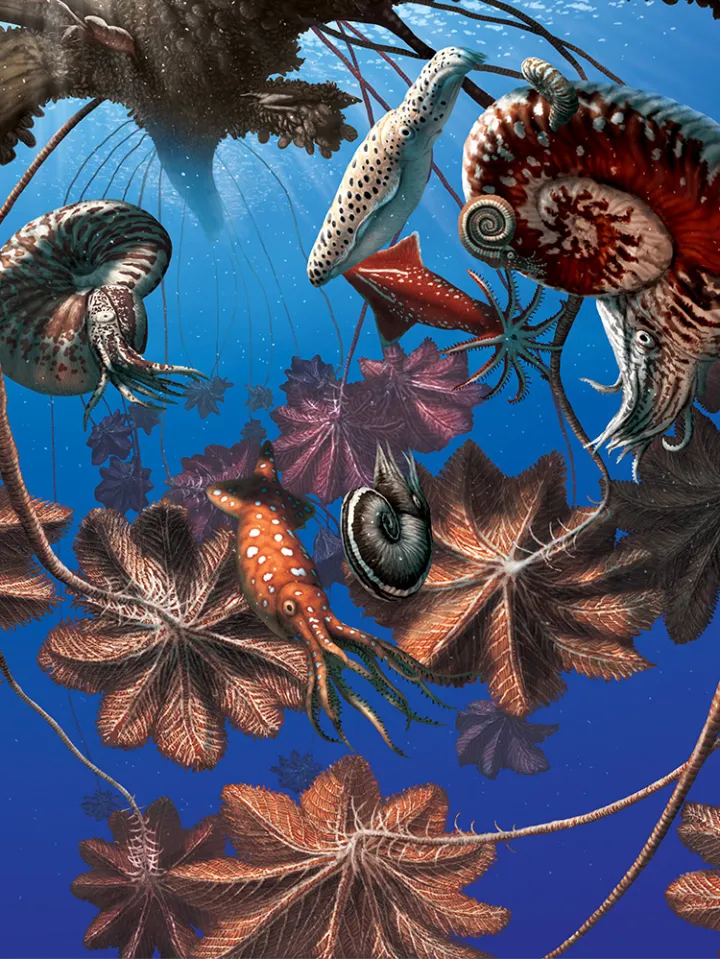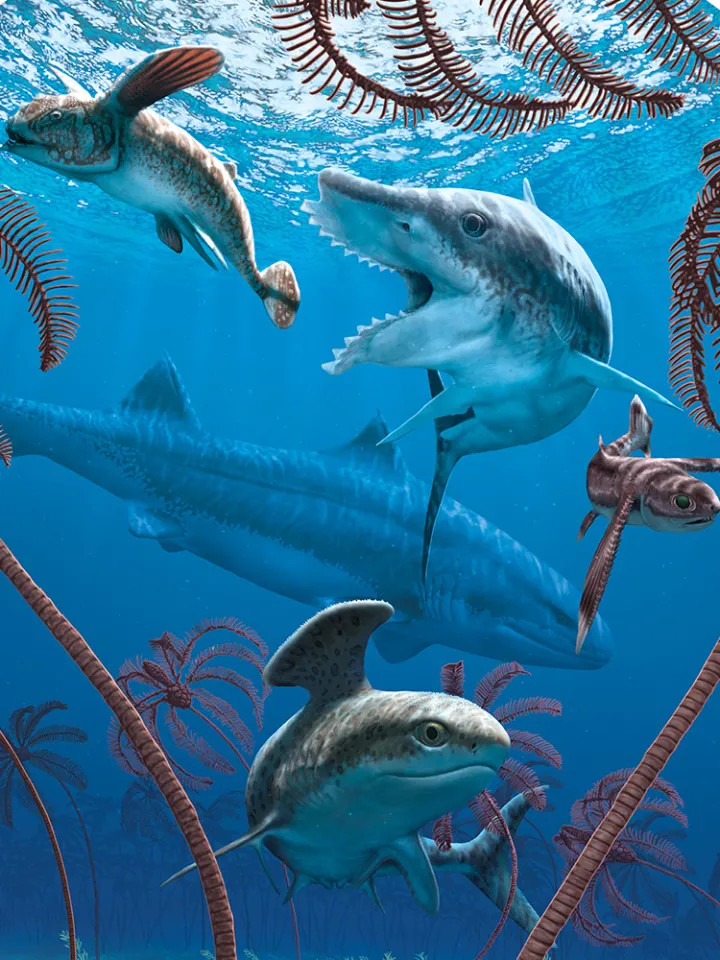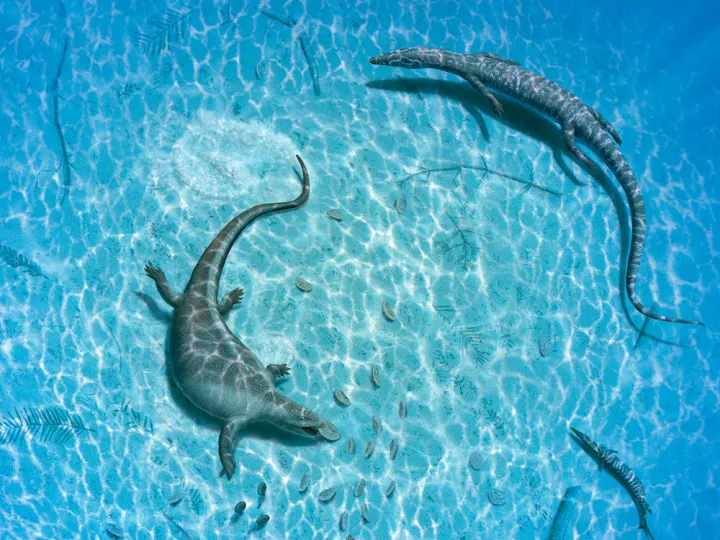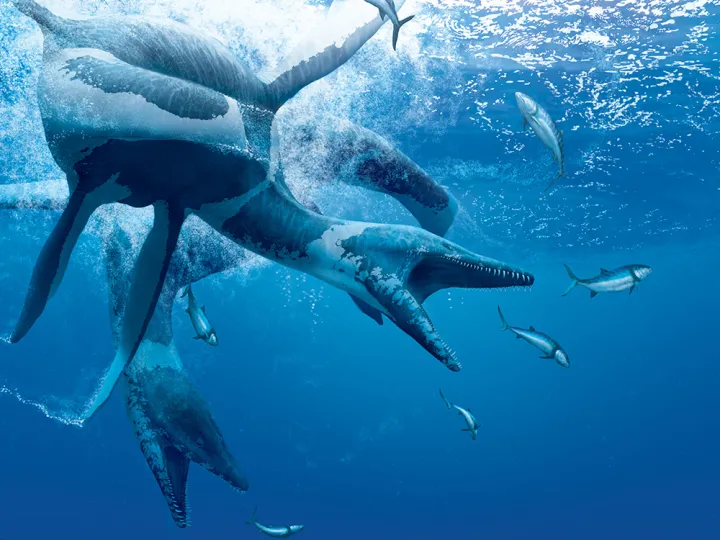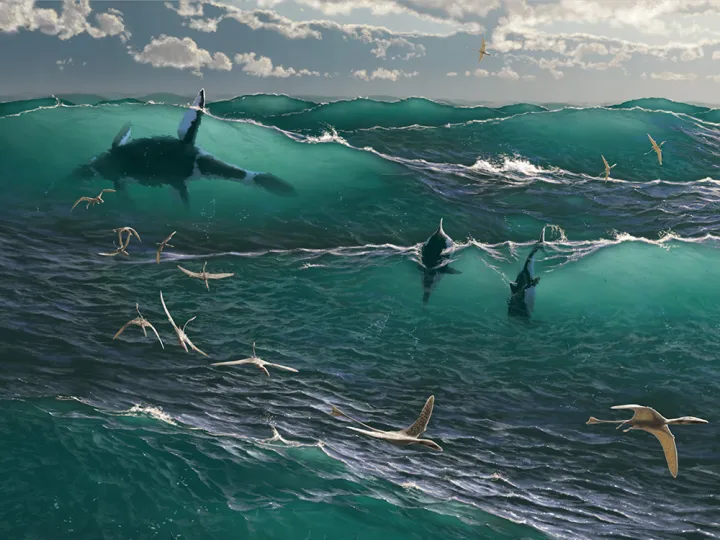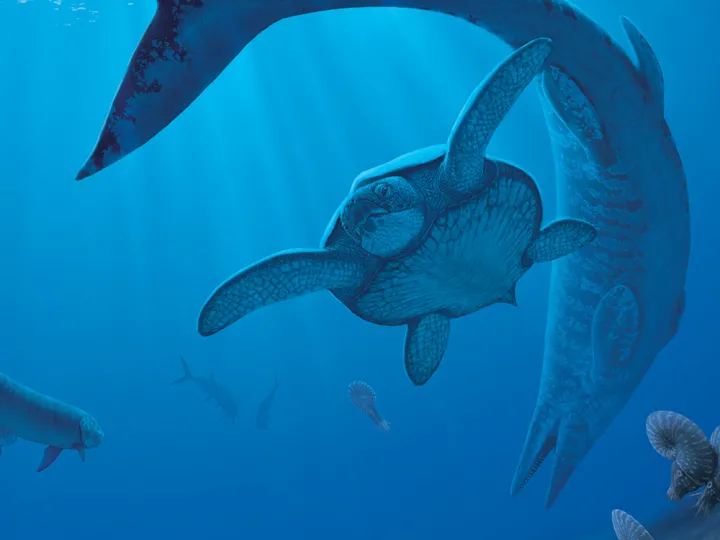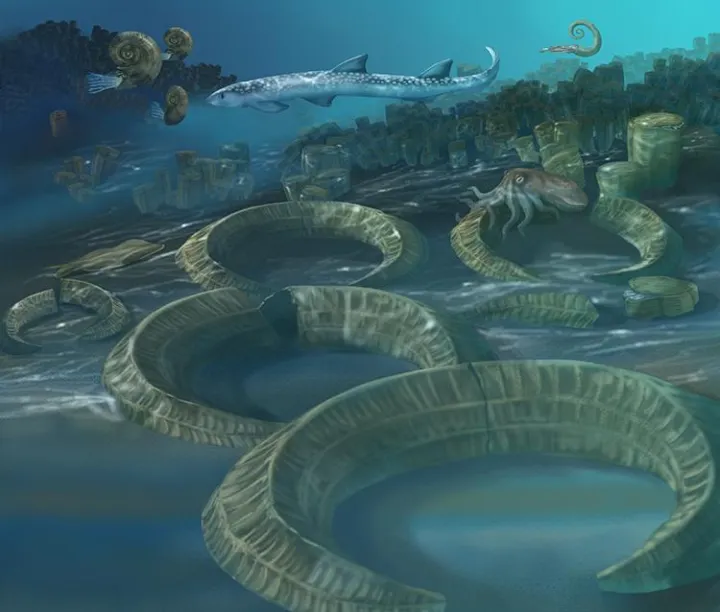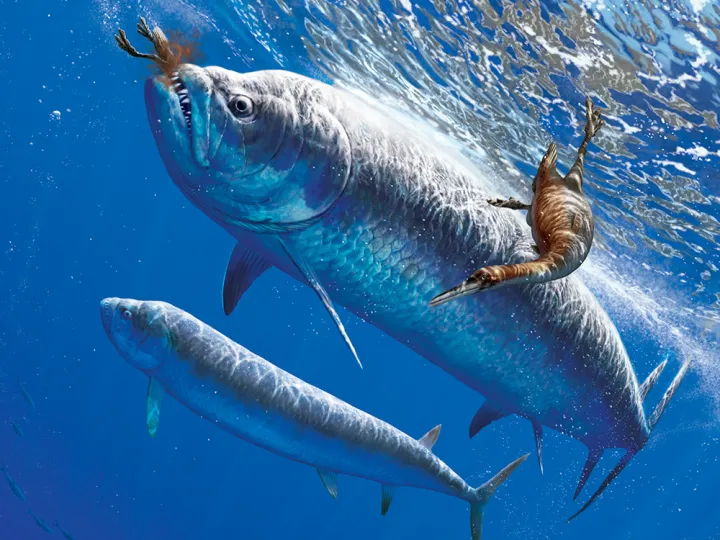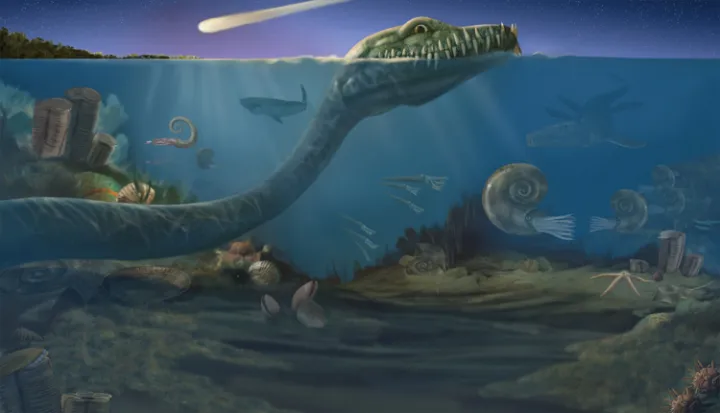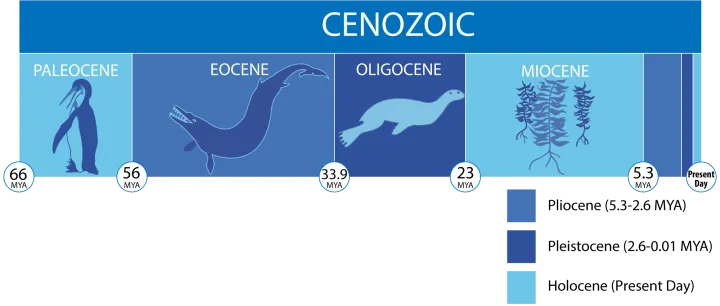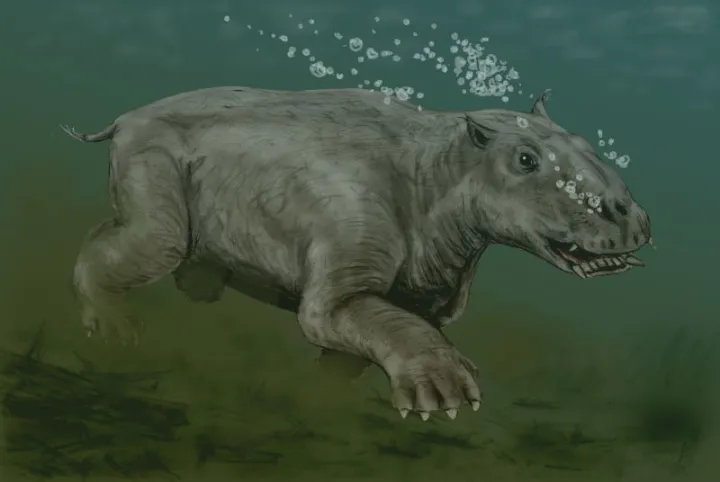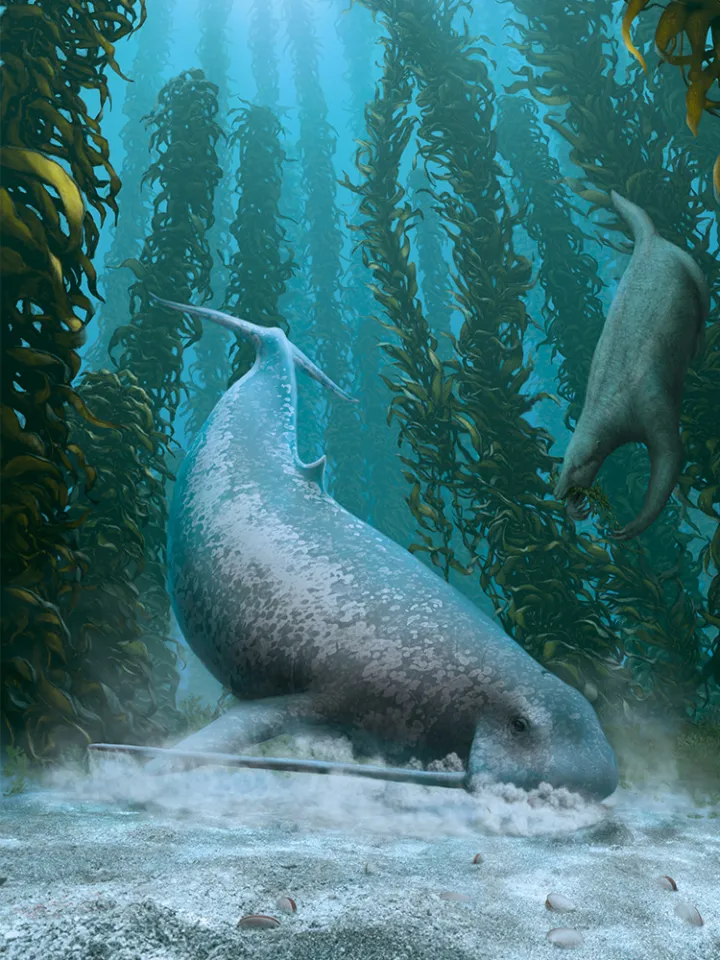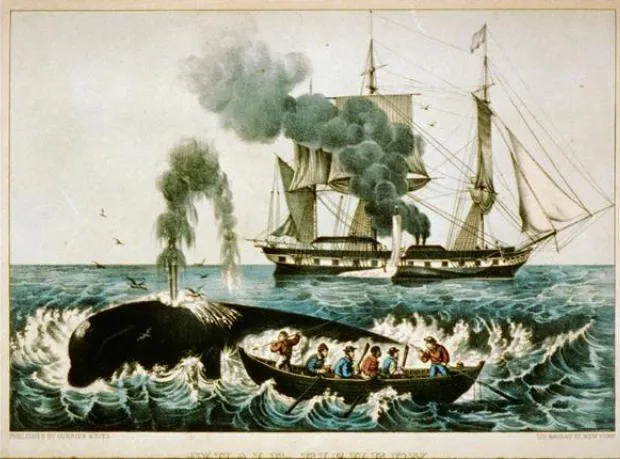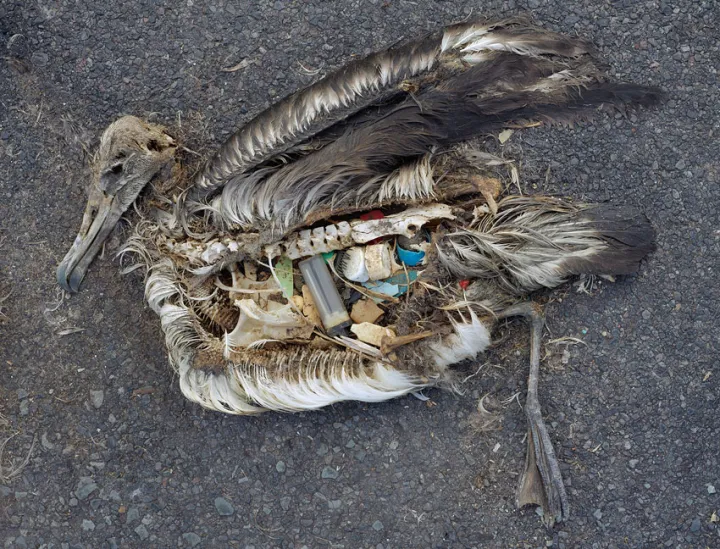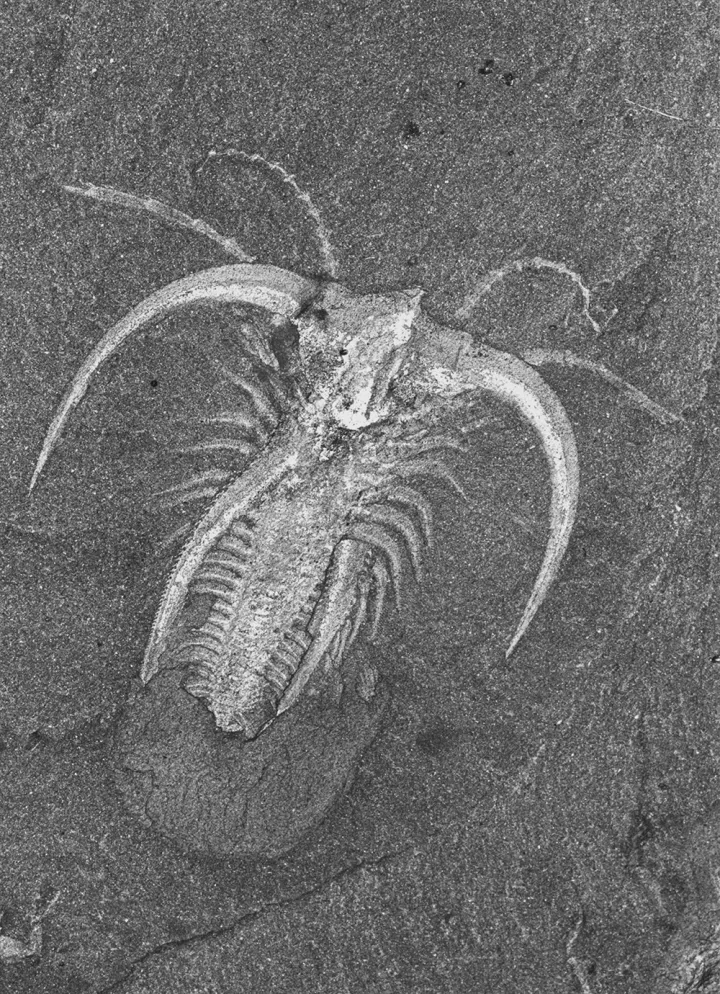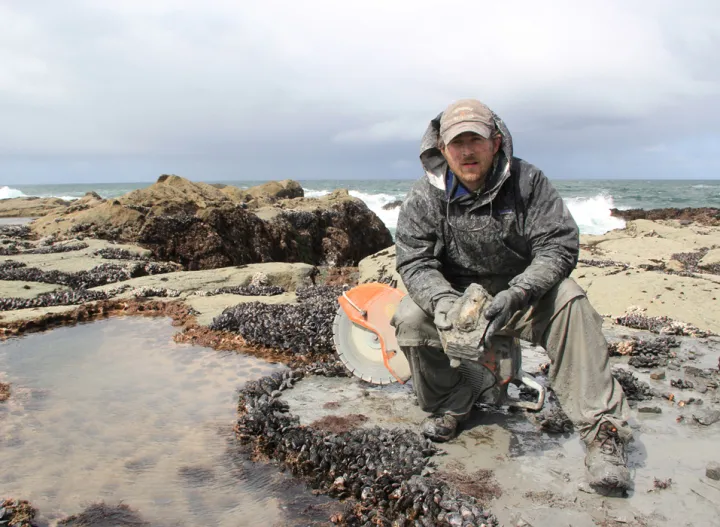
Ocean Through Time
Introduction
The ocean may seem like a vast and unchanging landscape, but the reality is that the world beneath the waves has continuously evolved over time. As terrestrial creatures, humans are largely unaware that much of life's history has taken place in the ocean. Indeed, life had been evolving and changing for more than 3 billion years—the majority of the planet's existence—before the first creatures made their way out of the water.
The first ocean lifeforms were microscopic, so small they would be invisible to the naked eye. Later, bizarre and alien-like creatures reigned supreme. Even creatures more familiar to us, like sharks, whales, and octopuses have long and storied pasts with ancestors very different than the creatures now roaming the seas. Some species existed for a geological moment before they went extinct, while others slowly adapted to changing seas. Evolution takes time, and when the ocean changed too rapidly for species to respond, mass extinctions occurred across the globe. This has happened five times and could happen again.
Are You An Educator?
Precambrian
Shortly after its formation, planet Earth was very different than the planet we are familiar with today. During Earth’s infancy, when the solar system was also beginning to take shape, the world’s surface was constantly bombarded by massive asteroids and comets, some over 120 miles (200 km) in diameter. For the first 500 million years or so, the environment was quite unstable.
The First Oceans of the Hadean
Between asteroid and comet bombardments, scientists believe enough time passed for vaporized water to condense and settle on the earth’s surface. According to the most recent scientific studies, an ancient ocean likely covered the entire planet 150 million years after the formation of Earth, about 4.4 billion years ago. Scientists know this through the discovery of ancient zircon crystals that were dated around this time. These crystals can hold up against temperatures that would melt and destroy most other rocks, and a subset discovered in Australia have a specific chemistry that indicates the crystals formed through a sedimentary process in a cool and wet environment—what scientists infer to be an ancient ocean floor.
The Microbes of the Archean
The first lifeforms emerged at least 3.5 billion years ago. These were simple, single-celled microbes that probably lived near hydrothermal vents, places where hot water spews from beneath the earth's crust and carries minerals from below. It was from this mineral-rich water that microbes obtained energy. The atmosphere at this point did not contain any oxygen. Instead, it consisted of methane, carbon dioxide, and hydrogen sulfide—gases that vented from the cooling planet through volcanic eruptions. Without oxygen, microbes most likely produced energy using sulfur. Microbes near hydrothermal vents in today’s oceans still carry out similar chemical reactions to obtain energy where sunlight does not exist.
By 2.3 billion years ago a bacterium emerged that could convert sunlight into usable energy. In the process, gaseous oxygen was formed. This blue-green microbe called a cyanobacterium was likely the first photosynthetic organism—and it was a game changer in the story of life on Earth. Over millions of years, oxygen continued to accumulate in the atmosphere, thanks to cyanobacteria and other photosynthetic organisms. It was this oxygen that would allow complex life to thrive in the millennia to come.
The World Takes Shape
By 650 million years ago the first supercontinent, Rodinia, formed. It is unclear exactly how big Rodinia was, although it is likely that its core landmass was the land that is now North America. The familiar shapes and locations of today’s continents were not the same—both Asia and Africa were split into pieces, Antarctica butted up against India and Australia, and the Americas were warped into unrecognizable shapes. On either side of the continent were the Panthalassic and the Pan-African Oceans.
Complex Life in the Ediacaran
The first recorded complex life forms appear around 560 million years ago, though they were very different than the creatures we are familiar with today. Many were soft-bodied, with only a few tube-like creatures having a stiff outer sheath. In some places, forests of fern-like fronds covered the ocean floor, but since they grew at depths beyond where light could reach they obtained energy by absorbing nutrients, like carbon, directly from the water rather than through photosynthesis. Unlike the filter feeding invertebrates of today, such as sea pens, these Ediacaran fronds likely did not have digestive organs and instead directly absorbed simple molecules, in a similar manner as bacteria. They also likely left no living descendants.
Other creatures relied on a thick microbial matt that covered the ocean floor for a source of energy. The first animals feasted on this dense matt of microbes. Some were unnamed burrowers, known only by the trails they left behind that evolved from aimless wanderers to proficient consumers with organized foraging routes. Other creatures, believed to be the early ancestors of animals, had bilateral symmetry, meaning that the left and right sides of the body were mirror images of each other. Spriggina is often compared to later arthropods, like the trilobites. The earliest confirmed animal, Dickinsonia moved along the seafloor, periodically parking in one place to consume the microbes and once that spot became depleted, moving to a more plentiful site. Another, Kimberella, had a proboscis that it used to rake the microbes towards itself to feed. These creatures have a hint of familiarity, but one of the most unique creatures of the Ediacaran is Tribrachidium. It had three spiraling arms that coiled into a disk. Trilateral symmetry, a rarity today, was a common feature in Ediacaran creatures.
Paleozoic
Viewed from space, the Paleozoic Earth would be a foreign world. During this era, seas flooded the continents and receded several times. During the early Paleozoic three small continents— Laurentia, Siberia, and Baltica—split apart from the rest of the supercontinent Gondwana and formed the Lapetus Ocean in between. Through the Ordovician period, the continents continued to drift and by the Silurian Period, Baltica collided with Laurentia, an event that resulted in today’s Appalachian Mountains. This new continent called Euramerica, and three newly-formed oceans, the Iapetus, Rheic, and Paleo-Tethys, spanned the smaller continents and Gondwana. By the end of the Paleozoic, the supercontinent Pangaea was beginning to take shape. Euramerica plowed into Gondwana, an event that caused many of the low-lying seas to dry up. Surrounding the entire continent, the Panthalassic Ocean covered the rest of the globe. Plants began to grow on land during the Ordovician, followed by invertebrates during the Silurian and finally vertebrates during the late Devonian. These early land dwellers were amphibian-like, eventually giving rise to reptiles by the end of the era.
Cambrian Explosion
The Cambrian period occurred approximately 542-488 million years ago and included the biggest evolutionary explosion in Earth’s history. Some researchers think this happened due to a combination of a warming climate, more oxygen in the ocean, and the creation of extensive shallow-water marine habitats. This environment would be ideal for the proliferation of new types of animals, including those that were larger and more complex in their body shapes and ecologies than their ancestors. The world’s first predators took to scanning the seabed from above or hiding in the sediments of the seafloor as disguised ambushers. On the seafloor, sponge-like creatures called Archaeocyatha grew in dense mounds and became prolific reef builders of the ocean. Though the first creatures to have shells arose in the Ediacaran, by the Cambrian this body feature became more common and it would prove as a critical defense mechanism against hungry predators. Many of these creatures were discovered in the Burgess Shale, an area of the Canadian Rockies with a large deposit of preserved Cambrian-age fossils
The First Predators
The largest and most fearsome looking predators to roam the seas during the Cambrian were the anomalocarids. The largest intact specimens discovered reach up to 3 feet in length. Some species of anomalocarids used two curled appendages to capture their prey and reel it in to a square ring of jagged teeth. They would also use crushing jaws to tear through the protective armor of hard creatures like trilobites. But unlike many of its relatives, one species of anomalocarid doesn't seem to be an apex predator. Like the whale shark and basking shark of today, the large shrimp-like creature called Tamisiocaris borealis was a filter feeder, and likely the first ever to live in the ocean. Scientists think the feather-like structures on its head were used to rake plankton from the sea. The appendages had finely spaced spines, further divided by smaller spines, which would have formed an efficient trap for small plankton.
Another formidable predator, Hurdia victoria has been nicknamed the Tyrannosaurus rex of the Cambrian era due to its relatively large size. While it never reached the size of the largest anomalocarids, some specimens reached 50 cm (around 20 inches), which was large for a time when most animals were about as big as a fingernail. Its prey consisted of trilobites and other smaller animals crawling on the seafloor. But not all predators stalked their prey from above. The ancient worm Ottoia prolifica lived in a self-constructed u-shaped home below the ocean floor. From there, Ottoia prolifica ambushed prey, which it would swallow headfirst. Most of its prey were small shelled animals related to mollusks, as well as worms, though there is evidence that they sometimes resorted to cannibalism.
Despite the impressive adaptations of the world’s first predators, those that were preyed upon soon developed their own line of defenses. Hallucigenia sparsa, a worm, is notable for the porcupine-like spikes that covered its back—an efficient way to ward off hungry jaws. Opabinia took a different approach and evolved five mushroom-like eyes that allowed it to see predators approaching from many directions. Additionally, its segmented portions were filled with fluid in order to be more flexible, an important trait for avoiding capture.
The Tale of the Trilobite
Perhaps the most famous creatures to emerge during the Cambrian were the trilobites. Relatives of insects, crabs, and spiders, there were over 20,000 trilobite species that lived between the Cambrian and the end of the Paleozoic Era when they went extinct, some 252 million years ago. Prolific survivors with a segmented body plan that could be easily modified and altered, they soon dominated the seafloor. It seems no method for catching food was beyond the scope of what a trilobite could do—predation, scavenging, filter feeding, and even forming a symbiotic relationship with bacteria were all methods of feeding employed by at least one species.
There is also evidence that trilobites were social creatures, migrating caravan style across the seafloor and meeting for mass molting events where they collectively shed their hard exoskeletons. One species even has a trident “fork” that protrudes from his head, an adornment believed to attract the opposite sex. As jawed and stealthy predators began to emerge, their simple body plans proved to be easy fodder for predators, but the trilobites adapted in stride. Some would curl up like pill bugs, their segments fitting together like a lock and key. Others developed thorny spines that would make it difficult for probing jaws to take hold and bite. Burrowing underneath sand and mud was another hiding tactic.
Life during the Paleozoic
Throughout the existence of Earth, the explosions and extinctions of life often take their cue from global changes. The quadrupling of diversity during the Ordovician is no different. During this period, most of the continental land was a part of the supercontinent Gondwana. Through the movement of plate tectonics, Gondwana gradually shifted south until it reached the South Pole. As this happened, the balmy, moderate temperatures of the planet turned ice cold, massive glaciers formed, and sea level dropped as much of the water used to form the ice came from the sea.
During the Ordovician, the majority of ocean life still lacked a backbone. Instead, life relied on stiff structures, like shells, to protect them from predators. Trilobites, armored by their stiff exoskeleton, remained prominent seafloor dwellers. Clams developed a dual shell system with left and right halves while brachiopods, a lesser-known shelled invertebrate, evolved top and bottom valves and occupied the muddy bottom.
Predators, too, required a tough outer skeleton. The eurypterids, a group of arthropods, were some of the most fearsome predators and could grow up to six feet (2 meters). With long tails that ended in a spike, they are often called "sea scorpions." Though today cephalopods are best known as soft-bodied creatures such as squid and octopuses, this group began as shelled creatures. Their simple shells evolved into complex spirals like the one still used by the nautilus. Without many vertebrates to compete with, the cephalopods were top predators.
Although the first vertebrates emerged during this time period, it wasn’t until millions of years later that they came to rule the seas. Vertebrates that lived during the Ordovician were jawless fish called ostracoderms that had protective plates covering their body.
Though they largely live in the deep ocean today, during the Cambrian through the Permian, crinoid forests covered parts of the seafloor. Known as sea lilies for their beautiful, feathered arms, these creatures are cousins of modern sea stars and sea urchins. When they grew in dense groups they created a protected, diverse ecosystem for other creatures to call home. But unlike the trees that make up the forests on land, crinoids are not plants. The invertebrates feed by catching drifting particles in their many arms. In a forest full of crinoids, competition for food was tough, so they evolved a variety of stalk heights which enabled them to capture food at different levels above the seafloor. The base of their stalks was modified to anchor the animal securely in the soft sediment. Crinoids were relative skyscrapers in the community, sometimes towering at heights of up to two meters (6.5 feet). In a crinoid community, lacy bryozoans occupied a lower level. Below them, huge numbers of brachiopods monopolized the muddy bottom. By the Permian, sharks cruised above these crinoid forests, while smaller bony fishes and shelled cephalopods weaved among the crinoid stalks.
One unique predator that swam in the ocean during the Permian, around 260-290 million-years-ago, was the shark called Helicoprion. This shark had a spiral set of teeth resembling a buzz saw, unlike any other shark. It is so unique that to this day scientists are still unsure as to how the teeth sat within the shark's jaw. Another predator, the placoderm, was a fish that had bony plates covering its body. Without teeth, it used the sharp edges of the plates covering its jaw to slice through its prey. Though initially highly successful and diverse, placoderms only existed for 50 million years, while sharks, a lineage that began at a similar time, have lasted to modern times.
Permian Extinction
The largest extinction ever in the history of Earth is the Permian extinction, an event that occurred roughly 252 million years ago. Scientists estimate that 90 percent of marine species disappeared over the course of about 60,000 years. The extinction was a response to dramatic changes in the Earth's atmosphere. Massive volcanic eruptions, spanning millions of years, spewed carbon dioxide and toxic gases out from inner Earth. As the gases accumulated temperatures rapidly fluctuated, oxygen levels plummeted, and the ocean became more acidic from acid rain. Ash that blocked the sun initially caused Earth's temperature to plummet, but lava soon burned coal deposits that released the greenhouse gas carbon dioxide into the atmosphere, raising the temperature.
The end Permian extinction drastically cut the diversity of life on Earth. Some groups went extinct, while a few species in other groups made it through. Sea urchins, once diverse during the Permian, were devastated—only one species survived. Ammonites, too, were hard hit. But the few that did survive became some of the most diverse predatory cephalopods.
Mesozoic
The world during the Mesozoic Era was a place both foreign and yet familiar when compared to Earth today. At this time, Pangea broke apart, and the massive Panthalassa Ocean broke into multiple basins. The Tethys Ocean split Asia from the rest of the land and the Atlantic Ocean began to form. The world was warm, keeping large ice caps from forming, which led to high global sea levels by the Jurassic that continued into the Cretaceous.
Reptiles of the Sea
Before large mammals, reptiles ruled the ocean. During the Mesozoic, the time period when dinosaurs roamed on land, many of these large creatures were the top predators in the ocean food chain and fed on fish, cephalopods, bivalves, and even one another. The most notable of these reptiles were the ichthyosaurs, plesiosaurs, mosasaurs, and sea turtles. Although they lived at a similar time as dinosaurs, marine reptiles were not dinosaurs since they evolved from a different ancestor. In fact, many of the reptiles in the ocean were only distantly related to one another. While the mosasaurs evolved from land-dwelling lizards, plesiosaurs, ichthyosaurs, and turtles each had their own separate evolutionary lineage.
At first glance, an ichthyosaur looks much like dolphins that live today. But ichthyosaurs are not mammals, nor are they fish, they are reptiles. Just as whales and sharks have adapted similar body plans to maximize swimming efficiency, ichthyosaurs evolved streamlined bodies built for swimming. The first ichthyosaurs that emerged roughly 250 million years ago had horizontally elongated tails and swam by undulating their entire bodies from side to side like an eel. But as they evolved large crescent shape tails, similar to those of present-day tuna, they began to propel themselves by fanning only their tail. This transformation indicates that ichthyosaurs likely began as coastal dwellers and then gradually moved to life in the open ocean. Like most fossilized creatures, it is difficult to assess exactly what they ate, but a few discoveries of fossilized meals indicate they preyed upon squid and small fish.
In the early 1800s, Mary Anning, a young paleontologist, discovered a peculiar fossil. It turns out it was the first discovered plesiosaur. These reptiles are identified by their four flippered limbs and (for most) a long neck. In coordinated movements the four flippers would equally propel the plesiosaur forward, a unique swimming method in the animal kingdom. While four flippered animals like sea turtles do exist, these creatures predominantly use the front flippers for thrust and the back for steering. Most plesiosaurs were predators. Some likely grazed along the seafloor looking for soft-bodied prey while others likely aggressively ambushed their prey from below, much like the great white shark of today.
Mosasaurs were relative latecomers during the span of the Mesozoic. While ichthyosaurs, plesiosaurs, and turtles reigned supreme since the early Triassic, the first mosasaur didn't emerge until the late Cretaceous, about 99 million years ago. But in a short period of time, they quickly diversified. Some developed bulbous teeth that they used to hammer away at oyster-like bivalves, while others developed razor-like teeth that could pierce and shred larger prey, including other mosasaurs. Most lived in shallow waters, but some, like the Tylosaurus, traveled far offshore and dove to deeper depths. Fossils of mosasaurs have been found on every continent, including Antarctica, indicating they lived throughout the entire globe. Like the dinosaurs and other reptiles in the sea, mosasaurs went extinct at the end of the Cretaceous.
The first fully marine turtles emerged during the Cretaceous Period, a span of time lasting between 145 and 66 million years ago. By 120 million years ago, they resembled the sea turtles we are familiar with today. The largest, Archelon, measured up to 15 feet from head to tail.
Bottom of the Food Chain
During the Mesozoic Era much of the plankton that exist today evolved. Coccolithophorids, microscopic plankton with calcium carbonate skeletons, were especially abundant and diverse during the Cretaceous Period. When coccolithophorids die and accumulate on the seafloor they form limestone and chalk. Trillions of these skeletons from the Cretaceous make up the famous White Cliffs in Dover, England. Oil, too, comes from dead plankton that accumulates on the seafloor and is buried for millions of years, but these plankton lack shells. More than 60 percent of the world's oil began as microscopic marine plankton in the Jurassic and Cretaceous.
Ancient Reefs
At the beginning of the Mesozoic Era during the Triassic, the ocean’s reefs were hard hit by the Permian extinction. It took millions of years for new, diverse seafloor ecosystems to evolve. By the time of the Jurassic, the seafloor was again thriving, but the reef's composition was different than the reefs we think of today. Presently, corals are the famous creatures known for their reef-building. They were also fairly abundant at various times through the Paleozoic Era and formed extensive reefs by the Devonian Period. But about 100 million years ago, during the heyday of the dinosaurs, the majority of reefs were built by mollusks called rudist clams. Like modern clams, rudists were bivalves, with two shells (or valves) joined at a hinge. But they sure didn’t look like modern clams! One major group of rudists grew upright, like big ice cream cones standing on end. The bottom valve was anchored on the ocean floor. Only the upper few inches poked above the sediments. The second major group of rudists had horn-shaped shells that lay flat on the ocean floor, preventing strong currents from flipping them over or washing them away.
Arms Race for Survival
The Mesozoic seas were thriving ecosystems structured much like the ecosystems that exist today, with phytoplankton forming the base of the food web and large predators at the top. The higher sea level during the Jurassic and Cenozoic created large areas of shallow seas where toothed fish, reptiles, birds, and flying pterosaurs stalked their prey. The first teleost fishes, fish with mobile jaws, evolved and their gaping, flexible mouths were effective for gulping prey. Carnivorous fishes like Xiphactinus were the most numerous predators in the Late Cretaceous seas. But that didn’t mean that other creatures were defenseless. Spines, spikes, and thick shells evolved to deter hungry predators, which in turn evolved teeth, claws, and beaks, with some even swallowing prey whole.
The Cretaceous-Paleogene Extinction
Around 66 million years ago a six-mile-wide asteroid smashed to Earth’s surface, an impact that caused tsunamis, acid rain, wildfire, and global cooling. With such a catastrophic change many species went extinct worldwide. One of the most famous extinctions because of the resulting disappearance of the dinosaurs, it is known as the K/Pg extinction.
The effects of this asteroid collision were global. Near the asteroid’s point of impact in present-day Mexico, shock waves would have obliterated any life. The rock under the shallow ocean where the asteroid hit would have been instantly vaporized and flung into the atmosphere where it would have acted as a veil and blocked the sun. Sulfur from vaporized rock made acid rain which likely killed corals and most plankton with shells made of lime. Organisms that lived beyond this impact zone would not have died immediately, but as their ecosystems collapsed, they too succumbed. Coastal areas were devastated by gigantic tsunamis that washed far inland. Increased heat sparked wildfires that ravaged forests and plains. Clouds of soot darkened the sky.
As the dust and soot lingered in the atmosphere, they blocked the warmth from the sun and Earth’s temperature dropped. Without sunlight, many plants on land and phytoplankton in the sea likely died. And without these sources of food, ecosystems across the globe collapsed. Ammonites, large marine reptiles, rudist clams, and many species of phytoplankton were particularly hard hit in the ocean.
Yet, life persisted. Years after the asteroid’s collision some organisms began to make a comeback. The K/Pg extinction cleared the way for new lineages of life to thrive. The mammals, once small and rodent-like, took advantage of the dinosaurs’ extinction and evolved in new directions, with some lineages eventually giving rise to the whales, seals, and manatees that live in the ocean today.
Cenozoic
The K/Pg extinction marked the end of the Mesozoic Era and the beginning of the Cenozoic Era, the Era that we live in today. At the beginning of the Cenozoic, the world’s continents and ocean basins were very similar to those that exist today, though the continents have continued to shift.
Shifting Plates
Around 34 million years ago the ocean temperature plunged in response to shifts in tectonic plates and a drop in atmospheric carbon dioxide. As South America and Australia broke away from Antarctica, oceanic currents dramatically changed and affected marine food webs across the globe. Mammals diversified rapidly, evolving new ways to feed, move about, and keep warm in the chilled ocean waters.
Later, a seemingly small land divide emerged that shifted global circulation again. For much of the Cenozoic, a seaway existed between the Pacific and Caribbean that allowed for ocean water and species to move between them. That all changed when the Pacific tectonic plate butted up against the Caribbean and South American plates during the Pliocene and the Isthmus of Panama began to take shape. This tectonic collision caused volcanic activity and the formation of mountains that stretched from North America to South America. This caused cooling and continental ice sheet growth especially in the Northern Hemisphere. The resultant drop in sea level further expanded the Panama land bridge.
As the Caribbean was cut off from the Pacific, the Atlantic Ocean became slightly saltier, and the Gulf Stream strengthened and propelled warm water from the equator up into the north. Today, the salty water of the Atlantic is a major engine for global ocean circulation. Ecosystems, too, reacted to the closure of the seaway. Cordoned off from the nutrient-rich waters of the Pacific, Caribbean species needed to adapt. The barrier led to the creation of new, closely related species, such as the Pacific goliath grouper and the Atlantic goliath grouper. The lack of nutrients in the waters of the Caribbean resulted in the high diversity of corals and algae we see today. Some species were able to make the adjustment, but others didn't fare so well.
The Reign of Mammals
It is also during this time that the true giants of the world came to be. The largest animal to ever live on the planet is the blue whale. But to become so large required a special set of circumstances. Baleen whales didn’t begin to get really big until roughly 5.3 million years ago, at the transition between the Miocene and the Pliocene. Scientists believe that this was a response to changes in the ocean environment. Around 3 million years ago the poles and temperate latitudes of the Earth were covered in ice. It was a period of time in which there was high seasonality and ice would consistently melt and refreeze over again. With each glacial melt came loads of nutrients from inland soils that flooded into the ocean and created pockets of high nutrients in coastal areas.
The icy landscape also created strong winds that pushed the water and created pockets of upwelling, much like how winds drive upwelling off the coast of California today. Also, as the world’s water froze in ice shelves, the oceans became saltier. This, in turn, drove large oceanic currents that brought nutrient rich water up from the depths of the ocean. In combination, these factors created a patchy ocean where pockets of nutrients were separated by miles of food deserts. Whales evolved massive bodies to not only store large quantities of energy but also to push aside the water for effective long-distance travel.
At the same time that baleen whales were growing to massive proportions feeding on tiny crustaceans, another marine mammal, Desmostylia, was grazing on kelp and seagrass in the shallows. These four-legged, gnarly-toothed creatures straddled the marine and terrestrial environments much like seals and sea lions of today, but with feet instead of flippers. By the middle of the Miocene they disappeared. They are the only order of marine mammals to go entirely extinct, and it is likely because sea cows and manatees were better suited for underwater life and outcompeted them for food.
Humans and the Ocean—The Anthropocene
Exploitation
Extinction of large oceanic animals may seem like a modern-day tragedy—however, humans have been killing off species for quite some time, and the loss of Stellar’s sea cow is a perfect example.
The Stellar’s sea cow is a relative of today's manatees and dugongs that once lived in an area that spanned from Japan across the Bering Strait and down to the Baja Peninsula. They were massive creatures, measuring up to 30 feet (9 meters) in length and weighing up to 10 tons. Named by naturalist and explorer Georg Stellar during an expedition in the mid-1700s, the sea cow survived only 27 years after being officially named, until 1769. Although it was sought-after prey for hunters, the loss of the sea cow was likely tied to the disappearance of another sought-after ocean mammal, the sea otter. Voracious consumers of the sea urchin, sea otters controlled the population of the urchins. But as Russian and Aleut hunters began to exploit the sea otters for their pelts, the sea otter population plummeted. Without a predator to keep them in check, the urchin population exploded. Urchins eat kelp, just as the sea cows did. And so, with the massive numbers of hungry urchins decimating the kelp forests, it is likely the sea cows starved.
Stellar’s sea cow is far from the only ocean creature brought to extinction by humans. In the 1800s, fishers and whalers traveling in the north slaughtered the flightless great auks by the thousands to supply food aboard ships, and by 1844 the species was extinct. The Japanese sea lion and Caribbean monk seal are other animals that have since been lost due to human exploitation.
Present Day
Today, the ocean is constantly being influenced by humans. The development of coastlines and overfishing are causing a significant loss in biodiversity. Pollution from runoff, oil spills, and plastic waste are killing species at an alarming rate. Carbon emissions from cars and power plants that provide electricity result in warming of our atmosphere, which is then melting glaciers and causing sea level to rise. Ocean currents are also responding to the fresher, warmer water. The excess carbon dioxide is dissolving into the water and creating more acidic seas.
As the world changes at a rate never before experienced in geologic time it is important to understand and reflect upon how past times of change affected life. A dramatically changing world often leads to mass extinctions, and in some cases, it takes millions of years for ecosystems to rebound, and they are never the same. The ocean will continue to exist— all life that inhabits it will not disappear, but a 6th mass extinction in the ocean would be very hard on humans.
At the Smithsonian
A Priceless Collection
The Smithsonian’s National Museum of Natural History houses one of the largest and most important collections of animal fossils in the world. These are not, as you might expect, dinosaur fossils. Surprisingly, you’ll find them in the invertebrate collections—the home of soft-bodied creatures, that are hardly ever fossilized: strange, rare, and exquisitely preserved sea-dwelling organisms from the Burgess Shale. These Cambrian-age fossils, 508 million years old, were discovered one hundred years ago by then-head of the Smithsonian, Charles D. Walcott. Beginning in 1909, Walcott collected some 65,000 specimens from the Burgess Shale, an area of the Canadian Rockies with a large deposit of preserved Cambrian-age fossils. For the past century, scientists have continued to study these amazing fossils, opening new windows into the complex and fascinating history of rapid diversification of life on Earth, called the “Cambrian Explosion.” The Museum today has two displays about the Burgess Shale: one in the David H. Koch Hall of Fossils and another in the Sant Ocean Hall.
Research
Ostracods and and Extinction
In a world that constantly changes, some species are winners and thrive in the new environment while others can’t cope and die out. But what determines the winners and losers? For some, it’s a matter of having the right anatomy. Ostracods, small shrimp-like creatures that live curled in shell-like casings, have a notable anatomical feature. In males, the penis is extremely large in comparison to the size of the rest of its body—it’s about a third of their size. But while size may be helpful in attracting mates in the short term, evolutionarily it can have its drawback. Smithsonian scientists Maria João Fernandes Martins and Gene Hunt have determined that ostracod species with larger penises are driven to extinction much faster than those with smaller penises. By studying ostracods that lived between 66 and 84 million years ago they determined that the species with larger penises became extinct 10 times faster than those with smaller penises. Another way to look at it is through time. While ostracods with small penises existed for an average of 15.5 million years, species with larger penises existed for only 1.6 million years. The study of ostracods is meant to shed light on a greater trend in evolution. Visual differences between sexes is not uncommon (think the peacock’s feather display and a moose’s antlers), and oftentimes while having a larger antler rack or brighter plumage is enticing for females, it can be detrimental to the male’s overall survival. This research suggests that species with larger adornments may be more susceptible to extinction.
Plankton Clues
Researcher Brian Huber studies microscopic fossils to learn about past climates. Specifically, he studies clues in the chemistry of foraminifera, a single-celled creature that both drifts in the ocean water column and sits at the bottom of the seafloor. The secret to how this microscopic creature informs us about our past climate lies in the shell. Foraminifera have an intricate shell covering that they build from molecules in the water. This shell is made of calcium carbonate and as the foraminifera builds its shell it takes oxygen molecules from the water to create the compound. The oxygen has different traits depending upon the temperature of the water. Some oxygen molecules are heavier than other oxygen molecules, a product of a bulkier core. The proportion of bulky oxygen to lighter oxygen enables scientists to determine what the temperature was when the foraminifera built its shell. By studying the shell chemistry of foraminifera over time scientists can see how temperature has changed. For example, shells from the Cretaceous show that the Antarctic ocean surface was a balmy 26 to 32 degrees C (79 to 90 degrees F).
The Evolution of Whales
From excavating fossilized whale skeletons in the Atacama Desert to examining them in the lab, researcher Nick Pyenson has dedicated his career to understanding the evolution of whales. His team has investigated questions that try to understand the evolution of whale anatomy, from the evolution of baleen to explaining why whales got so big. Through his travels around the globe, he and his team have discovered countless new species of ancient whales. The study of whale evolution in the past is becoming ever more relevant as today’s whales respond and adapt to a changing world.
Extinction
Douglas Erwin has spent his life studying the rise and fall of early creatures. Specifically, this includes studying how animals evolved during the Ediacaran and Cambrian Periods. Due to Erwin’s research, it is now known that the first animal evolved during the Ediacaran and not the Cambrian like previously thought. By studying Permian fossils, Erwin has also contributed to our understanding of why the Permian Extinction—the largest extinction in Earth’s history—came to be.
Ichthyosaur Gravesite
In the middle of the Nevada desert there is a massive ichthyosaur gravesite. Berlin Ichthyosaur State Park is the resting place of many ancient reptiles called ichthyosaurs. About 37 Shonisaurus popularis have been uncovered so far. In the late 1800s miners searching for silver stumbled upon the fossils, and later in the 1950s they were unearthed and studied by Berkeley paleontologist Charles Camp. Today, Smithsonian scientists are using 3D scanning technology to continue the work of Camp and allow people from around the world to view the fossil skeletons.



